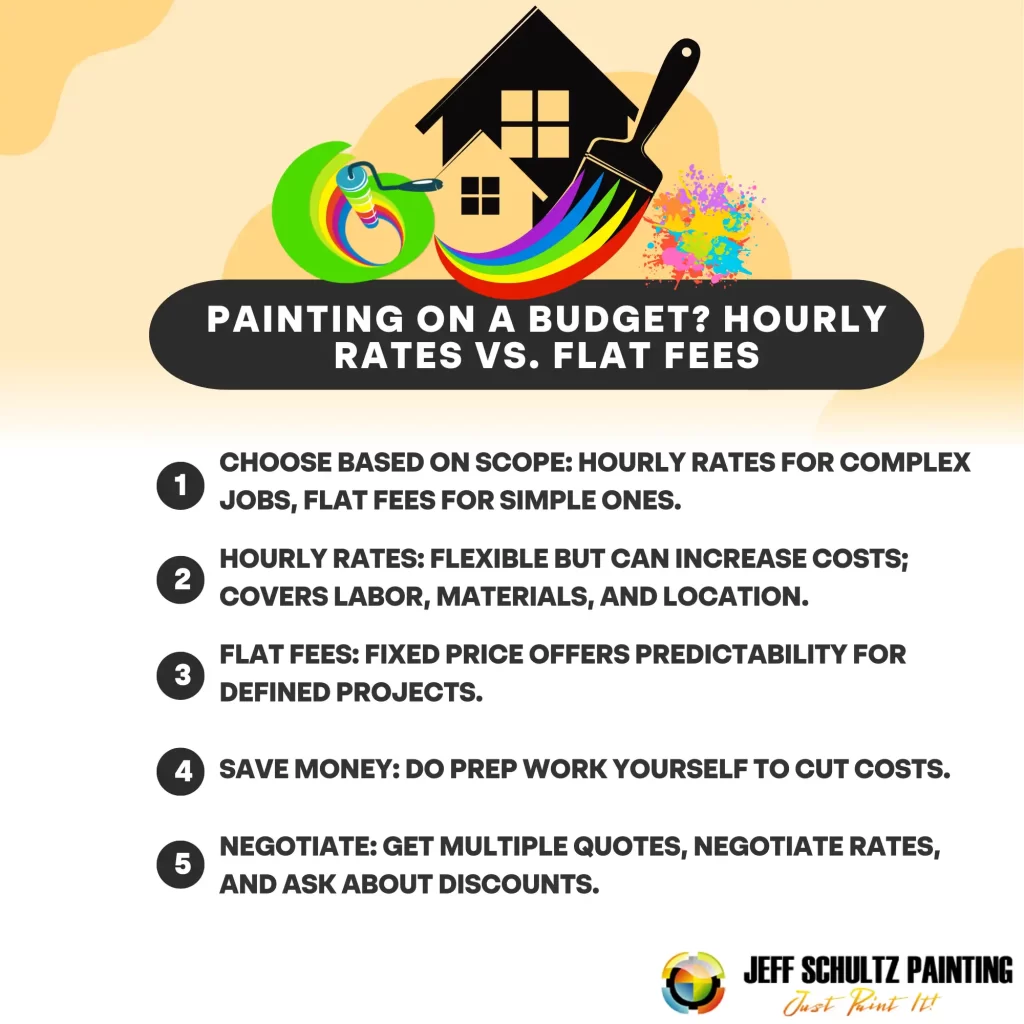The Two Main Pricing Structures
Revamping your living space with new paint is exciting yet daunting. You will need to answer the question, “how much do painters charge?”. But before you dive into color charts and brushstrokes, understanding the cost structure is crucial. Painting contractors typically offer two main pricing models: hourly rates and flat fees. This blog post will help you know painting costs and choose the right option for your budget and project.
Understanding Your Project and Budget

The first step is to define your project scope and budget clearly. Are you refreshing a single room or tackling the entire house? Do you envision a straightforward single-color repaint, or are you dreaming of a multi-colored masterpiece with intricate details? Having a clear vision will help you determine which pricing structure best aligns with your goals.
Understanding Hourly Rates
Hourly rates offer flexibility, particularly for projects with unforeseen complexities. Here’s a breakdown of what’s typically included:
- Labor Costs: This is the core element, reflecting the painter’s experience and skill level. Seasoned professionals with a proven track record will naturally command a higher hourly rate.
- Material Musings: While paint is the most obvious cost, remember drop cloths, masking tape, rollers, brushes, and other essentials.
The Geography Game: How Location Impacts Hourly Rates
Just like real estate, painting rates can vary significantly depending on your location. Big cities with a high cost of living typically see inflated hourly rates compared to smaller towns.
- Big City Blues or Small Town Savings? Expect premium rates in metropolitan areas due to factors like higher insurance costs and increased competition for skilled painters.
- Cost of Living Considerations: In areas with a lower cost of living, hourly rates tend to be more affordable. However, this doesn’t necessarily translate to a cheaper overall project cost, as some factors may even out the playing field.
Factors Affecting Hourly Costs
Several factors can influence the time (and, consequently, the cost) of your project before the first brushstroke.
Square Footage Showdown
As expected, larger rooms will naturally take longer to paint, pushing the project towards more hourly charges.
Walls, Ceilings, and Beyond
Painting ceilings or intricate woodwork is more time-consuming than tackling flat walls. Be prepared for potential hourly charges for these areas.
Plain Walls or Artistic Ambitions?
A simple one-color repaint will be quicker and less expensive than creating a multi-colored accent wall or applying a complex decorative finish.
- The Allure of Accent Walls: Accent walls add visual interest but require meticulous masking and potentially multiple coats, impacting the hourly rate.
- Specialty Finishes: Venetian plaster or other textured finishes are highly skilled endeavors that are likely to be billed by the hour.
Factors That Can Extend Painting Time (and Hourly Costs)
While not directly included in the hourly rate, prepping the space can significantly impact the project duration.
- Furniture Frenzy: Moving furniture is a time-consuming task that can add hours to the project. Consider tackling this yourself to streamline the process.
- Wall Repair Rodeo: Patching holes or cracks in walls extends the painting timeline. Addressing these issues beforehand can save you money in the long run.
Estimating Project Duration
A Time Travel Guide Through Your Home
Understanding typical room-by-room painting times can help you ballpark the hourly cost.
- Kitchen Capers: Estimating Time for the Culinary Canvas: Expect a more extended time commitment for kitchens due to cabinets and appliances.
- Bathroom Blitz: A Speedy Spruce Up or Hourly Hiccups? Bathrooms can be completed relatively quickly, especially if fixtures are left intact. However, unexpected issues like mold remediation can lead to additional hourly charges.
- Living Large: The Great Room Time Crunch: Large open spaces like living rooms can be deceiving. While seemingly straightforward, the vast square footage translates to more painting hours.
- Bedroom Bliss: A Haven of Restful Rates (and Painting Times): Bedrooms are smaller and less complex, leading to a quicker turnaround time and minimizing hourly charges.
A Calculation Caper
Multiply the square footage of your room by the estimated time per square foot for your project type. This will give you a rough idea of the total painting time. Most professional painters can provide this information during consultations.
Layers and the Impact on Time (and Hourly Costs)
Remember, most projects require multiple coats for optimal coverage. Factor this into your time estimate, as it can significantly impact the hourly cost.
The Flat Fee Alternative
A Fixed Price for Peace of Mind
Flat fees offer predictability and peace of mind. Unlike hourly rates, the total cost is fixed upfront, regardless of the time it takes to complete the project.
Defining the Project for a Flat Fee
For a flat fee to be accurate, the project scope needs to be clearly defined. This includes the square footage, number of rooms, desired paint colors and finishes, and any necessary surface repairs.
Ideal Projects for Fixed-Price Painting
Flat fees are ideal for straightforward projects with a well-defined scope.
- Straightforward Spaces: Single-Color Repaints for a Predictable Price: A single-color repaint of a room with minimal prep work is a prime candidate for a flat fee.
- Well-Defined Projects: Clear Expectations for a Flat Fee: Communicate your vision clearly to the painter upfront. The more details you provide, the more accurate the flat fee quote will be.
Hourly Rates vs. Flat Fees: Making the Right Choice
Weighing the Options: Considering Project Scope and Budget
The best pricing structure depends on your specific project. Here’s a breakdown to help you decide:
- Choose Hourly Rates for Complex projects with unforeseen complications, ongoing touch-up jobs, or projects whose scope might change.
- Choose Flat Fees for Well-defined projects with a clear scope, simple repaints, and situations where a fixed budget is crucial.
Flexibility vs. Predictability
Hourly rates offer more flexibility, mainly if the project scope changes mid-stream. However, this flexibility comes with the potential for cost overruns. Flat fees provide predictability, but any unforeseen issues can lead to the painter absorbing the extra cost.
When Hourly Rates Might Be Better
- Project Changes: If you decide to add an accent wall or change paint colors halfway through the project, hourly rates offer more flexibility in adjusting the final cost.
- Hidden Hazards: Unearthing unexpected problems like water damage or lead paint can derail a flat fee project, leading to additional charges. Hourly rates allow for adjustments to accommodate these unforeseen circumstances.
When Flat Fees Are the Way to Go
- Defined Project: A well-defined project with a clear scope and minimal risk of encountering surprises is ideal for a flat fee.
- Budget Certainty: Flat fees offer peace of mind by locking in the total cost upfront. This can be incredibly beneficial if you are dealing with a restricted budget.
Additional Considerations
Paint, Supplies, and Hidden Costs (For Both Options)
Regardless of whether you choose hourly rates or a flat fee, there will be additional material costs to consider. These can include:
- Paint: High-quality paint goes further and provides better coverage, but it also comes with a higher price tag.
- Supplies: Brushes, rollers, drop cloths, masking tape, sandpaper, and putty are just a few of the essentials you’ll need.
- Primer: Primer ensures a smooth finish and better paint adhesion, but it adds to the overall material cost.
How Prepping Saves You Money (Regardless of Fee Structure)
The more prep work you can do yourself, the less time the painter will spend on non-painting tasks, potentially reducing the overall cost under both hourly rates and flat fees. This includes:
- Removing furniture: Moving furniture out of the way can be a time-consuming task. Consider tackling this yourself to streamline the process.
- Patching minor wall imperfections: Patching holes or cracks in walls before painting saves time and minimizes the potential for hourly charges.
- Covering floors and fixtures: Protecting your floors and fixtures with drop cloths and masking tape minimizes cleanup time and avoids potential damage costs.
Understanding Coverage for Both Options
- Liability Insurance: Ensure the hired painter has liability insurance for accidental damage.
- Worker’s Compensation: If you choose hourly rates, verify that the painter has worker’s compensation insurance to cover any injuries sustained on the job.
Hourly vs. Flat Fee Completion Estimates
- Hourly Rates: Hourly rates are estimated based on the project scope and the painter’s experience. Be prepared for some flexibility depending on unforeseen circumstances.
- Flat Fees: Flat fee quotes typically include a timeframe for project completion. However, any significant deviations from the agreed-upon scope can lead to delays.
Tips for Budget-Conscious Painting
DIY or Hire a Pro? Weighing the Options and Your Skills
For smaller, straightforward projects, tackling the painting yourself can be a significant cost saver. However, for larger projects or those requiring expertise, hiring a professional painter is the wiser choice. Here are some factors to consider:
- Your Skill Level: Be honest about your DIY abilities. If you’ve never painted before, a professional can ensure a high-quality finish.
- Project Complexity: Complex projects like intricate trim work or textured finishes are best left to the professionals.
- Time Commitment: Painting an ample space can be time-consuming. Consider your available time and weigh it against the cost of hiring a professional.
Taking on Smaller Projects Yourself
If you’re handy and have the time, consider painting a bathroom or a small bedroom yourself. This can free up the budget for hiring a professional for more complex areas like the living room or kitchen.
Getting the Space Ready to Save on Time (and Costs)
As mentioned earlier, the more prep work you can do yourself, the less time the painter will spend on non-painting tasks. This translates to potential cost savings under both hourly rates and flat fees.
Combining Painting with Other Renovations
If you’re planning other renovations alongside painting, consider scheduling them concurrently. For example, having the floors refinished while the walls are being painted can minimize disruption and streamline the overall project timeline, reducing hourly painting charges.
Securing the Best Price (For Hourly Rates)
When negotiating hourly rates, consider getting quotes from several reputable painters. Be clear and upfront about your project scope and inquire about discounts for larger projects. Some painters offer a slightly lower rate if you provide the paint yourself.
Discounts for Upfront Payment (For Both Options)
Some painters offer a discount for upfront or early payment, regardless of whether you choose hourly rates or a flat fee. If your budget allows, inquire about this option to shave some money off the final bill.
Conclusion
Choosing Between Hourly Rates and Flat Fees
By understanding the factors that influence both hourly rates and flat fees, you can make an informed decision that aligns with your project scope and budget. Feel free to ask questions and get quotes from multiple painters before making your final choice.
Investing in Your Home with Confidence
When considering a home transformation with a fresh coat of paint, it’s important to factor in pricing, project scope, and additional costs. Find a reputable painter who aligns with your vision and budget and ensure clear communication throughout the process for a rewarding journey that adds value and beauty to your home.
Bonus Tip: Embrace the Color Journey!
Choosing a paint color can be both exciting and daunting. Feel free to explore different paint samples and consult with a skilled painter or a color consultant for expert advice. After all, a well-chosen color palette can significantly enhance the overall aesthetic of your space, making your investment in painting genuinely worthwhile.
So, grab your color wheel, unleash your inner decorator, and get ready to transform your home with a splash of color!
Get a Free Quote from Sarasota’s Trusted Painters!
Breathe new life into your Sarasota haven with a fresh coat of paint! Look no further if you need a trusted team of Sarasota house painters. For over 15 years, Jeff Schultz Painting has been serving the Sarasota community, transforming living spaces with exceptional painting services and outstanding customer care. Whether you’re envisioning a vibrant accent wall or a complete interior refresh, their skilled painters will meticulously execute your vision, ensuring a flawless and long-lasting finish.
Contact us today for a free quote and experience the difference quality and expertise can make in your painting project.









